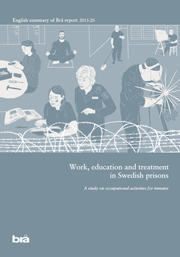- Start
- / Home
- / Publications

Work, education and treatment in Swedish prisons
A study on occupational activities for inmates
English summary of Brå report 2015:20
This study covers occupational activities in Swedish prisons and evaluates the positive effects of occupational activities on the inmates and how they can be developed.
The law requires inmates in Swedish prisons to participate in occupational activities during their sentence. The occupational activities may take the form of work, education, treatment programmes, or another structured activity. An inmate's repeated refusal to participate in assigned occupational activities may lead to a misconduct report. However, most inmates want to go to their occupational activities since they feel that it makes life in prison more manageable and makes time pass more quickly. Inmate participation in occupational activities can also be positive from a safety perspective; it can lead to fewer conflicts in the wings and closer contact between personnel and inmates. Last, but not least, occupational activities can contribute to the inmate's rehabilitation and thus reduce the risk of recidivism.
Although occupational activities are a central element of the sentence, there are no comprehensive studies regarding its content and quality. The Swedish National Council for Crime Prevention (Brå) has therefore been instructed by the Government to survey occupational activities in Swedish prisons. The situation in Sweden and other relevant countries is also to be compared. Finally, Brå will evaluate the positive effects of occupational activities on the inmates and shed light on how they can be developed.
The study is based on Brå's visits to twelve prisons in which a total of almost 200 people, both personnel and inmates, were interviewed. Two surveys were also sent out, one to conditionally released persons and one to heads of each prison. In addition, statistics from the Prison and Probation Service and the Swedish Public Employment Service were compiled for the report.
© The Swedish National Council for Crime Prevention, 2015
Authors: Johanna Kindgren, Linnea Littmann
urn:nbn:se:bra-628

